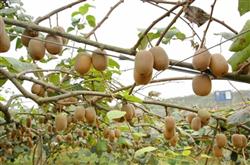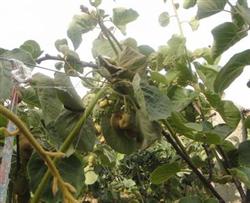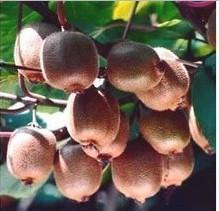Beware of the effect of high temperature on kiwifruit

Kiwifruit likes water and is afraid of waterlogging, light and exposure, so its natural distribution is mostly in places that avoid shade and damp, but there are almost no sunny and dry areas. Kiwifruit has been cultivated in Zhouzhi County for more than 20 years, and the high temperature weather in summer every year has a great impact on kiwifruit. It is of great significance for the development of kiwifruit industry to correctly understand the bad effect of high temperature on kiwifruit production and take corresponding preventive measures. 1. The effect of high temperature on kiwifruit 1. The effect of high temperature on kiwifruit leaves in June and July every year, when the temperature reached more than 35 ℃, kiwifruit leaves were exposed to intense light for 5 hours, that is, the leaf edge turned green, brown and black. If the high temperature lasts for more than 2 days, the kiwifruit shows that the leaf edge turns black and curls up, showing a burning shape. When the sun burn is serious, it can cause early defoliation, or even dead trees. 2. The effect of high temperature on the fruit continues to occur, which can make the part of the fruit surface exposed to sunlight turn brown and black, and the pericarp cells become keratinized, thus limiting the growth of the fruit. The fruit ripening consequence of mild sunburn is small and the fruit surface is not clean, which loses its due commodity value. In severe cases, the fruit is soft rotten or even fester. 2. The occurrence regularity of high temperature sunburn the sunburn caused by high temperature mainly occurs in the early hanging orchard where the tree potential is weak. According to the survey, under the same conditions, the incidence of sunburn in orchards aged 3-5 years can reach 15% Mel 30%; in adult gardens over 5 years old, the incidence rate is only 2% Mel 3%. Among trees of the same age, if the number of new shoots is more than 20, the incidence rate is 50%. If the number of new shoots is less than 10, the incidence rate can reach 20%, 30%, or even higher. Thus it can be seen that the leaf surface coefficient of orchard is the key to affect the degree of sunburn. In addition, the ground management of the orchard is also an important factor in the occurrence of sunburn. Under the same conditions, the sunburn of weedy orchards is much lighter than that of clear ploughing orchards. For adult gardens with grass and covering an area of more than 60%, sunburn generally does not occur. Even in the same orchard, a few weak trees are sunburned and the strong ones are intact. Third, the cause of high-temperature sunburn: 1. Kiwifruit leaves are related to the special structure of leaves. To a certain extent, kiwifruit leaves can play a shading role, but the physiological structure of kiwifruit leaves is special, because there are no two guard cells in its leaf pores. Therefore, the water transpiration of the tree can not be effectively controlled. When the temperature is too high and the water absorbed by the roots can not meet the needs of transpiration, the water in the tree is out of balance, and the first part showing water loss is the leaf margin with the largest distribution of leaf pores. 2. Related to climate and phenology, because Zhouzhi is located in the Loess Plateau and the climate is relatively dry, the continuous high temperature of more than 35 ℃ begins to appear in June every year. This period is the peak of kiwifruit growth, fruit development and new shoot growth need a lot of nutrients and water, at this time, the leaves are tender, the pericarp is thin, if the nutrients and water are not enough, it will lead to the relative weakness of the tree and the decrease of resistance. Therefore, June and July are the peak period of sunburn; in August, the tree has luxuriant branches, increased leaf and fruit maturity, and sunburn decreased. 4. The relationship between high temperature and other diseases. 1. The symptoms of sunburn and brown spot are very similar. In production, people often mistake sunburn for brown spot disease and spray control, resulting in drug damage caused by high temperature. In fact, as long as careful observation, the two can be distinguished: (1), brown spot symptoms. The disease is a fungal disease from the symptom point of view, although brown spot can also cause leaf blackening, but the disease is first along the second side of the vein to produce black spots, and then gradually expand, Zhouzhi area often began to occur in August. (2) symptoms of sun fever. Sunburn belongs to physiological disease and has no pathogen. In terms of time, it mainly occurred from June to July. The disease occurs rapidly, the leaf margin can turn black within one day, but the color is lighter than brown spot disease; if the leaf edge is black and curl, but the leaf edge is still green, except for drug damage and fertilizer damage, it is usually sunburn. 2. High temperature and root rot are destructive diseases of kiwifruit, and their pathogens are mainly fungi and bacteria. Because the infected site is in the underground, the tree often shows symptoms when the disease is serious, while the symptoms on the tree are mainly due to root damage, which limits the absorption and transport of nutrients and water, so that the tree shows wilting symptoms and even death. High temperature can aggravate the transpiration of kiwifruit, thus intensifying the contradiction between water supply and demand, resulting in repeated wilting of leaves during the day, spreading at night, and finally death. 5. Taking measures to prevent high temperature harm is one of the effective ways to prevent high temperature harm. According to the comparative investigation of clear ploughing garden and grass garden, when the natural temperature reaches 35 ℃, the temperature in clear ploughing garden can reach 45-48 ℃. The reason why the temperature in the garden is higher than the natural temperature is that the orchard is affected by both direct sunlight and ground reflected light, and the air humidity in the park is about 5% lower than the natural humidity. In recent years, Zhouzhi implemented the grass system, advocated and guided fruit growers to plant hairy vetch in the orchard, and the incidence of sunburn was greatly reduced. The main reason is that the reflected light of the garden is reduced, the temperature is reduced, and the humidity of the air in the park is increased. According to the determination, the air humidity in the orchard that has been growing grass for more than 2 years is 15%, 18% higher than the natural humidity, and the moisture in the air makes up for part of the transpiration. In addition, cultivating strong trees, keeping branches reasonably and scientific summer shearing are also good ways to prevent the harm of high temperature.
- Prev

Beware of kiwifruit burning in high temperature
In recent years, due to the high efficiency of Actinidia deliciosa, our fruit farmers compete for introduction, but because we have done little research on it, we have taken a lot of detours. Kiwifruit likes water and is afraid of waterlogging, light and exposure, so its natural distribution is mostly in places that avoid shade and damp, but there are almost no sunny and dry areas. Zhouzhi County has been around for more than 20 years.
- Next

High temperature should prevent kiwifruit sunburn early
Kiwifruit is particularly sensitive to the wind. In summer, the growth of branches is very exuberant, and it is easy to be broken by the wind from the base, which not only affects the growth and fruit of the current year, but also affects the yield of the next year. At the same time, the wind is also easy to scratch leaves and fruits, making fruit trees susceptible to disease and reducing the commerciality of fruits. Strong winds can also cause fallen leaves and affect flowers.
Related
- Moge, come on! The staff of the peasant association in the producing area of cantaloupe were frightened when the crowd gathered.
- Causes and Solutions of low Fruit setting rate of Apple
- Symptoms and control measures of passion fruit virus disease
- Fruit growing lesson: how do apple orchards keep high yields?
- Can you build orchards in the mountains? What are the pros and cons?
- How to manage the coloring period of Crisson grape?
- This paper introduces the processing technology of two kinds of fig products.
- How much is a month for retired teachers in rural areas by 2020?
- How can strawberry planting increase sugar content? We should pay attention to management in many aspects.
- What are the cultivation techniques on how to improve the yield of golden fruit?

